PEP小学英语说课稿
- 格式:doc
- 大小:207.00 KB
- 文档页数:16
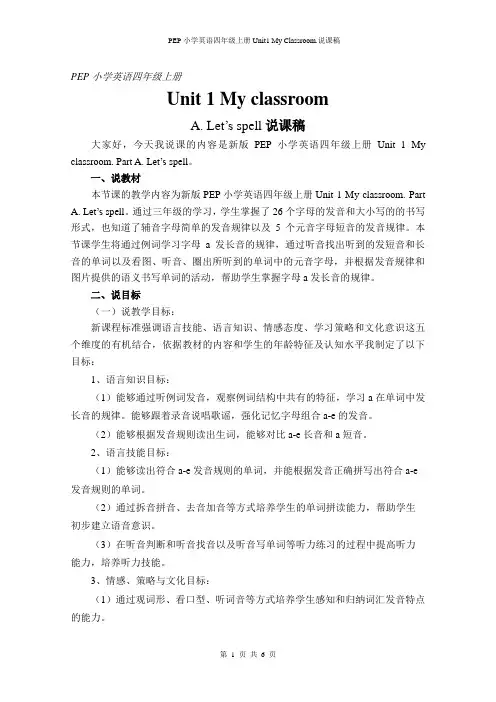
PEP小学英语四年级上册Unit 1 My classroomA. Let’s spell说课稿大家好,今天我说课的内容是新版PEP小学英语四年级上册Unit 1 My classroom. Part A. Let’s spell。
一、说教材本节课的教学内容为新版PEP小学英语四年级上册Unit 1 My classroom. Part A. Let’s spell。
通过三年级的学习,学生掌握了26个字母的发音和大小写的的书写形式,也知道了辅音字母简单的发音规律以及5个元音字母短音的发音规律。
本节课学生将通过例词学习字母a发长音的规律,通过听音找出听到的发短音和长音的单词以及看图、听音、圈出所听到的单词中的元音字母,并根据发音规律和图片提供的语义书写单词的活动,帮助学生掌握字母a发长音的规律。
二、说目标(一)说教学目标:新课程标准强调语言技能、语言知识、情感态度、学习策略和文化意识这五个维度的有机结合,依据教材的内容和学生的年龄特征及认知水平我制定了以下目标:1、语言知识目标:(1)能够通过听例词发音,观察例词结构中共有的特征,学习a在单词中发长音的规律。
能够跟着录音说唱歌谣,强化记忆字母组合a-e的发音。
(2)能够根据发音规则读出生词,能够对比a-e长音和a短音。
2、语言技能目标:(1)能够读出符合a-e发音规则的单词,并能根据发音正确拼写出符合a-e 发音规则的单词。
(2)通过拆音拼音、去音加音等方式培养学生的单词拼读能力,帮助学生初步建立语音意识。
(3)在听音判断和听音找音以及听音写单词等听力练习的过程中提高听力能力,培养听力技能。
3、情感、策略与文化目标:(1)通过观词形、看口型、听词音等方式培养学生感知和归纳词汇发音特点的能力。
(2)通过小组竞赛、歌谣诵读、分角色表演、“找朋友”游戏、看看说说、单词竞读等活动或方式激发学生学习英语的兴趣,调动学生学习积极性,培养学生的合作精神和集体荣誉感。
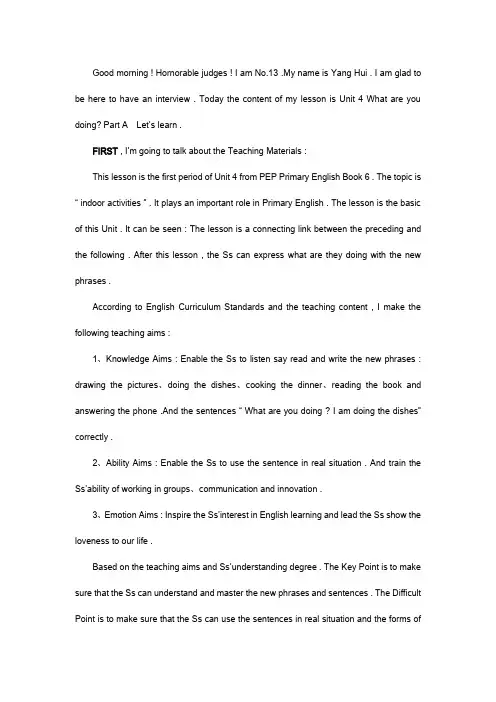
Good morning ! Hornorable judges ! I am No.13 .My name is Yang Hui . I am glad to be here to have an interview . Today the content of my lesson is Unit 4 What are you doing? Part A Let’s learn .FIRST, I’m going to talk about the Teaching Material s :This lesson is the first period of Unit 4 from PEP Primary English Book 6 . The topic is “ indoor activities ” . It plays an important role in Primary English . The lesson is the basic of this Unit . It can be seen : The lesson is a connecting link between the preceding and the following . After this lesson , the Ss can express what are they doing with the new phrases .According to English Curriculum Standards and the teaching content , I make the following teaching aims :1、Knowledge Aims : Enable the Ss to listen say read and write the new phrases : drawing the pictures、doing the dishes、cooking the dinner、reading the book and answering the phone .And the sentences “ What are you doing ? I am doing the dishes” correctly .2、Ability Aims : Enable the Ss to use the sentence in real situation . And train the Ss’ability of working in groups、communication and innovation .3、Emotion Aims : Inspire the Ss’interest in English learning and lead the Ss show the loveness to our life .Based on the teaching aims and Ss’understanding degree . The Key Point is to make sure that the Ss can understand and master the new phrases and sentences . The Difficult Point is to make sure that the Ss can use the sentences in real situation and the forms ofVerb - ing .THEN , I will talk about the Teaching Method :In order to break through the key and difficult points , according to the characteristic of the Ss in Grade Five , I mainly adopt Task –Based Language Approach、Situational Approach、Communicative Approach、Systemic Reaction Approach and Game Teaching Approach .NEXT , I will talk about the Teaching Procedure :I will finish the lesson in five steps .Step 1 : Warm upI begin with my lesson with a song < What are you doing ? > and free talk .P : It’s important to form a better English learning surrounding for the Ss by singsing and doing some body language at the same time . It’s helpful in reviewing what they have learned and preparing the Ss for the next step. It also can bring me closer to the Ss .Step 2 : Presentation1、Present the new words and the sentences with pictures and some questions and write them on the blackboard .Especially pay attention to the forms of Verb –ing and the pronunciation .P : With the help of CAI , T can set the situation to help the Ss to understand the phrases better . Also the pictures can attract the Ss’attention and inspire their interest . The questions can promote their divergent thinking and make the class more interesting .Step 3、practicePractice the new word with a game : The Sound of Reading . Then the Ss practice adialogue with the new phrases and act it out .P : It can not only improve the Ss’speaking ability b ut also enhance their self confidence . The Ss will be more interested in the class and participate in the class actively.Step 4 : consolidationPlay a guessing game : devide the Ss into two groups ,one S do an action ,other teams guess .P : This activity can foster their conciousness of good cooperation and proper competition .Step 5 : HomeworkLet the Ss tell each other what is he doing at home and finish the survey .P : It’s necessary for the Ss to do some extensive exercise to consolidate the knoeledge they learnt . Through making the survey , the Ss can practice their speaking ability after class and show their loveness to life .FINALLY , I will talk about the Blackboard Design .I will write the key phrases with pictures on the left and the key sentences on the right and use red chalk to stress the difficult points . It’s clear for the Ss to know the key and difficult points .That’s all ! Thanks for your listening !。
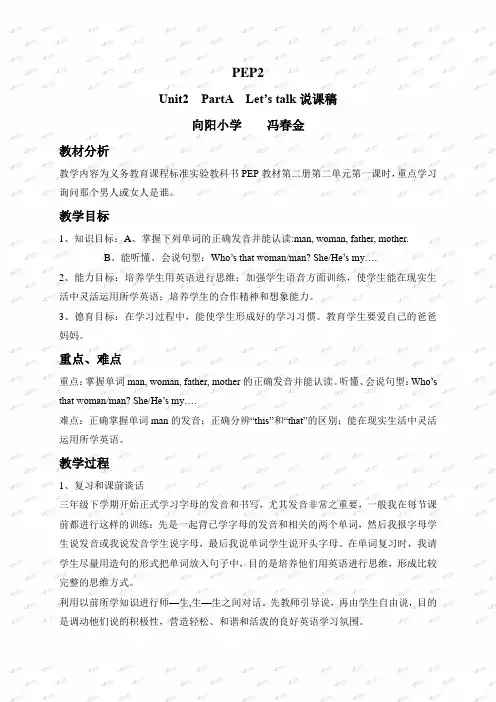
PEP2Unit2 PartA Let’s talk说课稿向阳小学冯春金教材分析教学内容为义务教育课程标准实验教科书PEP教材第二册第二单元第一课时,重点学习询问那个男人或女人是谁。
教学目标1、知识目标:A、掌握下列单词的正确发音并能认读:man, woman, father, mother.B、能听懂、会说句型:Who’s that woman/man? She/He’s my….2、能力目标:培养学生用英语进行思维;加强学生语音方面训练,使学生能在现实生活中灵活运用所学英语;培养学生的合作精神和想象能力。
3、德育目标:在学习过程中,能使学生形成好的学习习惯。
教育学生要爱自己的爸爸妈妈。
重点、难点重点:掌握单词man, woman, father, mother的正确发音并能认读。
听懂、会说句型:Who’s that woman/man? She/He’s my….难点:正确掌握单词man的发音;正确分辨“this”和“that”的区别;能在现实生活中灵活运用所学英语。
教学过程1、复习和课前谈话三年级下学期开始正式学习字母的发音和书写,尤其发音非常之重要,一般我在每节课前都进行这样的训练:先是一起背已学字母的发音和相关的两个单词,然后我报字母学生说发音或我说发音学生说字母,最后我说单词学生说开头字母。
在单词复习时,我请学生尽量用造句的形式把单词放入句子中,目的是培养他们用英语进行思维,形成比较完整的思维方式。
利用以前所学知识进行师—生,生—生之间对话。
先教师引导说,再由学生自由说,目的是调动他们说的积极性,营造轻松、和谐和活泼的良好英语学习氛围。
2、学与教过程A、“Who’s that”和“Who’s this”的学习我指着身边的一个学生,向他们提问:Who’s this boy?可能出现两种情况:1、部分学生能听懂;2、一个也听不懂。
因为这是一个新学单词。
从教学过程来看,是第二种情况。
因为他们的回答是“Yes.”于是我反复多次提问,但还是很多人不太懂,既尔板书“Who”,告诉他们意思是“谁”。
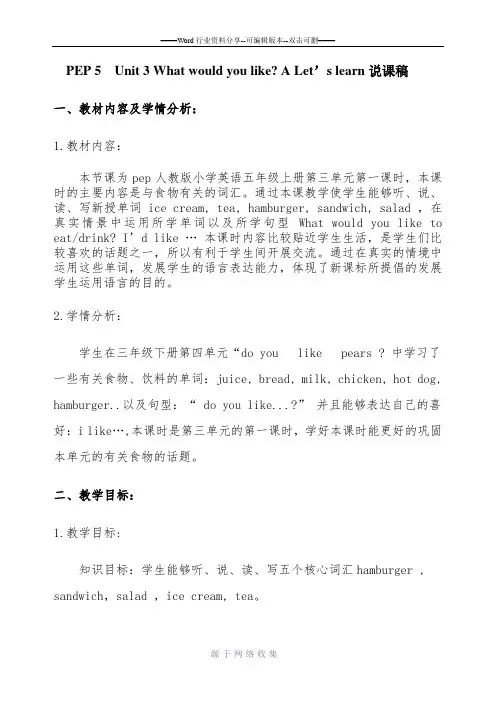
PEP 5 Unit 3 What would you like? A Let’s learn说课稿一、教材内容及学情分析:1.教材内容:本节课为pep人教版小学英语五年级上册第三单元第一课时,本课时的主要内容是与食物有关的词汇。
通过本课教学使学生能够听、说、读、写新授单词ice cream, tea, hamburger, sandwich, salad ,在真实情景中运用所学单词以及所学句型 What would you like to eat/drink? I’d like …本课时内容比较贴近学生生活,是学生们比较喜欢的话题之一,所以有利于学生间开展交流。
通过在真实的情境中运用这些单词,发展学生的语言表达能力,体现了新课标所提倡的发展学生运用语言的目的。
2.学情分析:学生在三年级下册第四单元“do you like pears ? 中学习了一些有关食物、饮料的单词:juice, bread, milk, chicken, hot dog, hamburger..以及句型:“ do you like...?”并且能够表达自己的喜好:i like…,本课时是第三单元的第一课时,学好本课时能更好的巩固本单元的有关食物的话题。
二、教学目标:1.教学目标:知识目标:学生能够听、说、读、写五个核心词汇hamburger , sandwich,salad ,ice cream, tea。
能力目标:学生能够运用核心句型What would you like toeat/drink? I’d like …在真实的情境中进行交流。
情感、态度、价值观目标:通过本课时的教学,使学生能够了解中西方食物的差异,能够在课堂上完成学习任务,感受语言学习的魅力,获得成功的体验,从而引发和培养学生的内在动机。
最终形成学习语言的积极态度。
2.教学重点:1)学生能够听、说、读、写五个核心词汇2)学生能够综合运用、巩固核心句型What would you like to eat/drink? I’d like …在真实的情境中进行交流。
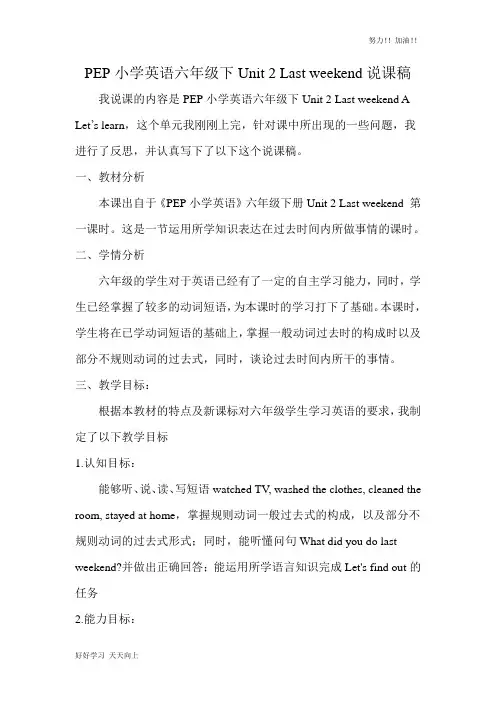
PEP小学英语六年级下Unit 2 Last weekend说课稿我说课的内容是PEP小学英语六年级下Unit 2 Last weekend A Let’s learn,这个单元我刚刚上完,针对课中所出现的一些问题,我进行了反思,并认真写下了以下这个说课稿。
一、教材分析本课出自于《PEP小学英语》六年级下册Unit 2 Last weekend 第一课时。
这是一节运用所学知识表达在过去时间内所做事情的课时。
二、学情分析六年级的学生对于英语已经有了一定的自主学习能力,同时,学生已经掌握了较多的动词短语,为本课时的学习打下了基础。
本课时,学生将在已学动词短语的基础上,掌握一般动词过去时的构成时以及部分不规则动词的过去式,同时,谈论过去时间内所干的事情。
三、教学目标:根据本教材的特点及新课标对六年级学生学习英语的要求,我制定了以下教学目标1.认知目标:能够听、说、读、写短语watched TV, washed the clothes, cleaned the room, stayed at home,掌握规则动词一般过去式的构成,以及部分不规则动词的过去式形式;同时,能听懂问句What did you do last weekend?并做出正确回答;能运用所学语言知识完成Let's find out的任务2.能力目标:能够用一般过去时描述自己在过去时间里所做的事情3.情感目标:通过本课语言知识的学习,教育学生多熟悉身边的人所做的事情,并能做到经常关心他人四、教学重难点1.重点:听说读写短语watched TV, washed the clothes, cleaned the room, stayed at home;能听说句子What did you do last weekend?并能就过去时间所做的事情进行简单回答2.难点:学生对本课的几个短语都比较熟悉,但动词的过去式第一次出现,因此,这几个短语的动词过去式的构成及其发音是本课时的难点。
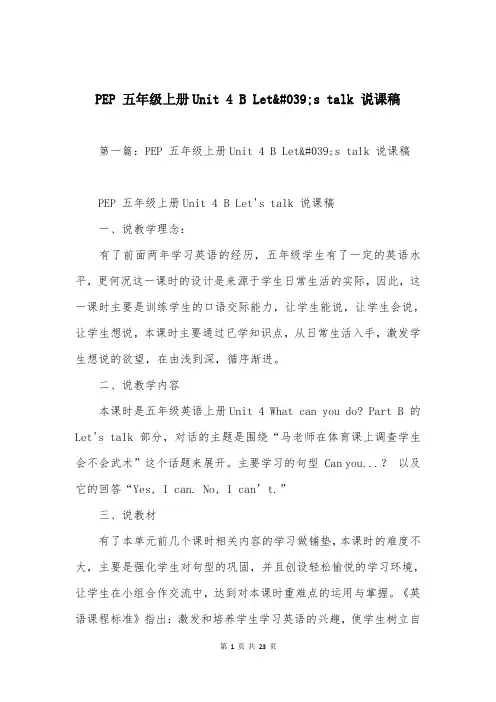
PEP 五年级上册Unit 4 B Let's talk 说课稿第一篇:PEP 五年级上册Unit 4 B Let's talk 说课稿PEP 五年级上册Unit 4 B Let's talk 说课稿一、说教学理念:有了前面两年学习英语的经历,五年级学生有了一定的英语水平,更何况这一课时的设计是来源于学生日常生活的实际,因此,这一课时主要是训练学生的口语交际能力,让学生能说,让学生会说,让学生想说,本课时主要通过已学知识点,从日常生活入手,激发学生想说的欲望,在由浅到深,循序渐进。
二、说教学内容本课时是五年级英语上册Unit 4 What can you do? Part B 的Let's talk部分,对话的主题是围绕“马老师在体育课上调查学生会不会武术”这个话题来展开。
主要学习的句型 Can you...?以及它的回答“Yes, I can. No, I can’t.”三、说教材有了本单元前几个课时相关内容的学习做铺垫,本课时的难度不大,主要是强化学生对句型的巩固,并且创设轻松愉悦的学习环境,让学生在小组合作交流中,达到对本课时重难点的运用与掌握。
《英语课程标准》指出:激发和培养学生学习英语的兴趣,使学生树立自信心,养成良好的学习习惯和形成有效的学习策略,发展学生自主学习的能力和合作精神是小学英语教学的基本任务。
在认真分析教材的基础上,针对学生实际,确立了本课时的教学目标及教学重、难点。
1、知识目标(1)能听、说、认读单词“learn”,“any”,“problem”,和词组“No problem”。
(2)能灵活运用句型“Can you…?”进行问答练习。
2、能力目标:(1)能够运用所学单词及本课时重点句型。
(2)能听懂“Let’s try”部分的录音并完成选择任务。
3、情感目标:(1)激发学生学习英语的兴趣,使学生树立学习英语的自信心。
(2)培养学生主动学习的意识和与他人进行沟通交流的能力,让学生感受到合作学习的乐趣和效率。
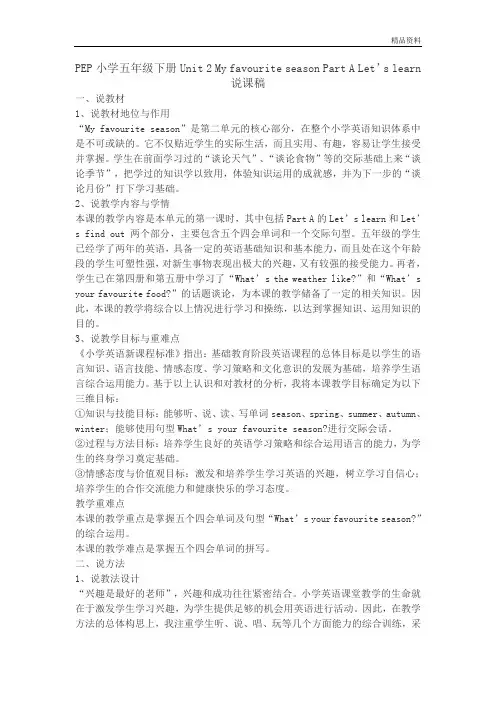
PEP小学五年级下册Unit 2 My favourite season Part A Let’s learn说课稿一、说教材1、说教材地位与作用“My favourite season”是第二单元的核心部分,在整个小学英语知识体系中是不可或缺的。
它不仅贴近学生的实际生活,而且实用、有趣,容易让学生接受并掌握。
学生在前面学习过的“谈论天气”、“谈论食物”等的交际基础上来“谈论季节”,把学过的知识学以致用,体验知识运用的成就感,并为下一步的“谈论月份”打下学习基础。
2、说教学内容与学情本课的教学内容是本单元的第一课时,其中包括Part A的Let’s learn和Let’s find out两个部分,主要包含五个四会单词和一个交际句型。
五年级的学生已经学了两年的英语,具备一定的英语基础知识和基本能力,而且处在这个年龄段的学生可塑性强,对新生事物表现出极大的兴趣,又有较强的接受能力。
再者,学生已在第四册和第五册中学习了“What’s the weather like?”和“What’s your favourite food?”的话题谈论,为本课的教学储备了一定的相关知识。
因此,本课的教学将综合以上情况进行学习和操练,以达到掌握知识、运用知识的目的。
3、说教学目标与重难点《小学英语新课程标准》指出:基础教育阶段英语课程的总体目标是以学生的语言知识、语言技能、情感态度、学习策略和文化意识的发展为基础,培养学生语言综合运用能力。
基于以上认识和对教材的分析,我将本课教学目标确定为以下三维目标:①知识与技能目标:能够听、说、读、写单词season、spring、summer、autumn、winter;能够使用句型What’s your favourite season?进行交际会话。
②过程与方法目标:培养学生良好的英语学习策略和综合运用语言的能力,为学生的终身学习奠定基础。
③情感态度与价值观目标:激发和培养学生学习英语的兴趣,树立学习自信心;培养学生的合作交流能力和健康快乐的学习态度。
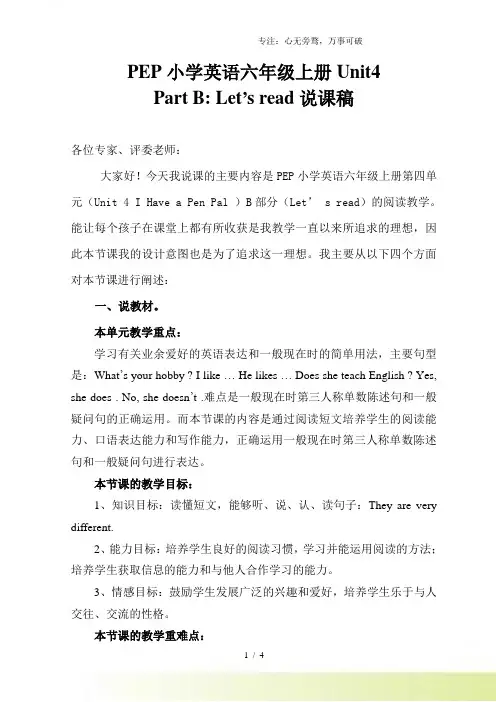
PEP小学英语六年级上册Unit4Part B: Let’s read说课稿各位专家、评委老师:大家好!今天我说课的主要内容是PEP小学英语六年级上册第四单元(Unit 4 I Have a Pen Pal )B部分(Let’ s read)的阅读教学。
能让每个孩子在课堂上都有所收获是我教学一直以来所追求的理想,因此本节课我的设计意图也是为了追求这一理想。
我主要从以下四个方面对本节课进行阐述:一、说教材。
本单元教学重点:学习有关业余爱好的英语表达和一般现在时的简单用法,主要句型是:What’s your hobby ? I like … He likes … Does she teach English ? Yes, she does . No, she doesn’t .难点是一般现在时第三人称单数陈述句和一般疑问句的正确运用。
而本节课的内容是通过阅读短文培养学生的阅读能力、口语表达能力和写作能力,正确运用一般现在时第三人称单数陈述句和一般疑问句进行表达。
本节课的教学目标:1、知识目标:读懂短文,能够听、说、认、读句子:They are very different.2、能力目标:培养学生良好的阅读习惯,学习并能运用阅读的方法;培养学生获取信息的能力和与他人合作学习的能力。
3、情感目标:鼓励学生发展广泛的兴趣和爱好,培养学生乐于与人交往、交流的性格。
本节课的教学重难点:重点:引导学生正确理解短文内容,正确运用一般现在时第三人称单数陈述句和一般疑问句。
难点:培养学生理解阅读、口语表达、写作的能力。
二、说教法。
(一)音乐、律动教学法:利用歌曲将学生的注意力生动愉快地引入课堂,同时利用Let’s chant的音乐、律动让学生在轻松愉悦的环境里进行写作创作,也为课堂气氛增色不少。
(二)谈话引入法。
通过对旧知识的回顾,谈话引入本节课教学情景,使课堂衔接自然而流畅。
(三)任务教学法:给学生分别布置一定的学习任务,并通过自己的努力完成相应的任务,使每个学生都有事可作,有所收获。
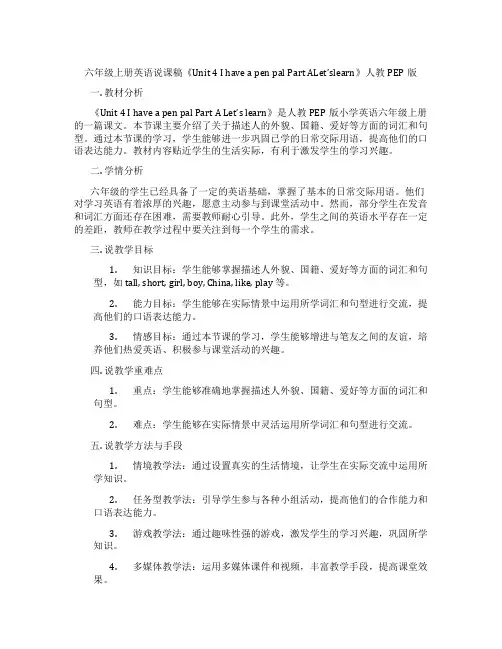
六年级上册英语说课稿《Unit 4 I have a pen pal Part ALet’slearn》人教PEP版一. 教材分析《Unit 4 I have a pen pal Part A Let’s learn》是人教PEP版小学英语六年级上册的一篇课文。
本节课主要介绍了关于描述人的外貌、国籍、爱好等方面的词汇和句型。
通过本节课的学习,学生能够进一步巩固已学的日常交际用语,提高他们的口语表达能力。
教材内容贴近学生的生活实际,有利于激发学生的学习兴趣。
二. 学情分析六年级的学生已经具备了一定的英语基础,掌握了基本的日常交际用语。
他们对学习英语有着浓厚的兴趣,愿意主动参与到课堂活动中。
然而,部分学生在发音和词汇方面还存在困难,需要教师耐心引导。
此外,学生之间的英语水平存在一定的差距,教师在教学过程中要关注到每一个学生的需求。
三. 说教学目标1.知识目标:学生能够掌握描述人外貌、国籍、爱好等方面的词汇和句型,如 tall, short, girl, boy, China, like, play 等。
2.能力目标:学生能够在实际情景中运用所学词汇和句型进行交流,提高他们的口语表达能力。
3.情感目标:通过本节课的学习,学生能够增进与笔友之间的友谊,培养他们热爱英语、积极参与课堂活动的兴趣。
四. 说教学重难点1.重点:学生能够准确地掌握描述人外貌、国籍、爱好等方面的词汇和句型。
2.难点:学生能够在实际情景中灵活运用所学词汇和句型进行交流。
五. 说教学方法与手段1.情境教学法:通过设置真实的生活情境,让学生在实际交流中运用所学知识。
2.任务型教学法:引导学生参与各种小组活动,提高他们的合作能力和口语表达能力。
3.游戏教学法:通过趣味性强的游戏,激发学生的学习兴趣,巩固所学知识。
4.多媒体教学法:运用多媒体课件和视频,丰富教学手段,提高课堂效果。
六. 说教学过程1.热身(5分钟):教师与学生进行简单的口语交流,询问学生上周的学习情况,引导学生进入学习状态。
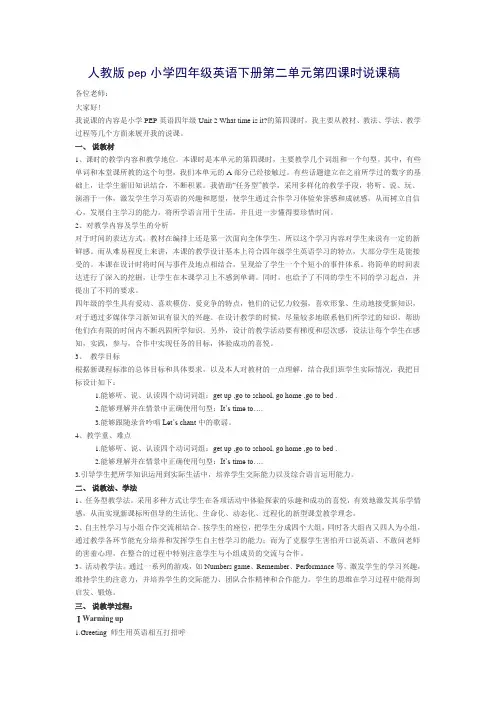
人教版pep小学四年级英语下册第二单元第四课时说课稿各位老师:大家好!我说课的内容是小学PEP英语四年级Unit 2 What time is it?的第四课时,我主要从教材、教法、学法、教学过程等几个方面来展开我的说课。
一、说教材1、课时的教学内容和教学地位。
本课时是本单元的第四课时,主要教学几个词组和一个句型。
其中,有些单词和本堂课所教的这个句型,我们本单元的A部分已经接触过。
有些话题建立在之前所学过的数字的基础上,让学生新旧知识结合,不断积累。
我借助“任务型”教学,采用多样化的教学手段,将听、说、玩、演溶于一体,激发学生学习英语的兴趣和愿望,使学生通过合作学习体验荣誉感和成就感,从而树立自信心,发展自主学习的能力。
将所学语言用于生活,并且进一步懂得要珍惜时间。
2、对教学内容及学生的分析对于时间的表达方式,教材在编排上还是第一次面向全体学生,所以这个学习内容对学生来说有一定的新鲜感。
而从难易程度上来讲,本课的教学设计基本上符合四年级学生英语学习的特点,大部分学生是能接受的。
本课在设计时将时间与事件及地点相结合,呈现给了学生一个个短小的事件体系。
将简单的时间表达进行了深入的挖掘,让学生在本课学习上不感到单调。
同时,也给予了不同的学生不同的学习起点,并提出了不同的要求。
四年级的学生具有爱动、喜欢模仿、爱竞争的特点,他们的记忆力较强,喜欢形象、生动地接受新知识,对于通过多媒体学习新知识有很大的兴趣。
在设计教学的时候,尽量较多地联系他们所学过的知识,帮助他们在有限的时间内不断巩固所学知识。
另外,设计的教学活动要有梯度和层次感,设法让每个学生在感知,实践,参与,合作中实现任务的目标,体验成功的喜悦。
3、教学目标根据新课程标准的总体目标和具体要求,以及本人对教材的一点理解,结合我们班学生实际情况,我把目标设计如下:1.能够听、说、认读四个动词词组:get up ,go to school, go home ,go to bed .2.能够理解并在情景中正确使用句型:It’s time to….3.能够跟随录音吟唱Let’s chant中的歌谣。
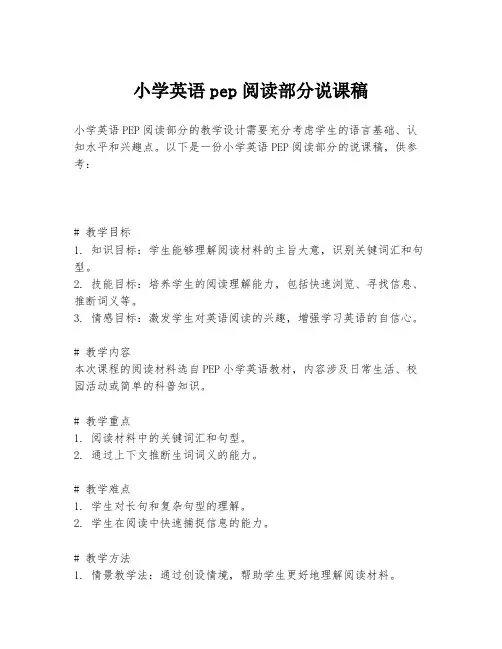
小学英语pep阅读部分说课稿小学英语PEP阅读部分的教学设计需要充分考虑学生的语言基础、认知水平和兴趣点。
以下是一份小学英语PEP阅读部分的说课稿,供参考:# 教学目标1. 知识目标:学生能够理解阅读材料的主旨大意,识别关键词汇和句型。
2. 技能目标:培养学生的阅读理解能力,包括快速浏览、寻找信息、推断词义等。
3. 情感目标:激发学生对英语阅读的兴趣,增强学习英语的自信心。
# 教学内容本次课程的阅读材料选自PEP小学英语教材,内容涉及日常生活、校园活动或简单的科普知识。
# 教学重点1. 阅读材料中的关键词汇和句型。
2. 通过上下文推断生词词义的能力。
# 教学难点1. 学生对长句和复杂句型的理解。
2. 学生在阅读中快速捕捉信息的能力。
# 教学方法1. 情景教学法:通过创设情境,帮助学生更好地理解阅读材料。
2. 任务型教学法:设计任务驱动学生主动阅读,提高阅读效率。
3. 合作学习法:鼓励学生小组讨论,共同解决问题。
# 教学过程1. 导入(Lead-in):- 通过提问或展示图片,激发学生对话题的兴趣。
- 复习与阅读材料相关的词汇和句型。
2. 呈现(Presentation):- 向学生展示阅读材料,解释生词和难句。
3. 练习(Practice):- 学生独立阅读,完成教师设计的阅读任务,如填空、选择、回答问题等。
- 小组合作,讨论阅读材料中的问题。
4. 产出(Production):- 学生根据阅读材料进行角色扮演或复述故事。
- 学生进行小组讨论,分享阅读心得。
5. 总结(Summary):- 教师总结学生在阅读中遇到的问题和解决方法。
- 强调阅读技巧的重要性。
6. 作业(Homework):- 布置相关的阅读练习,鼓励学生在课外进行自主阅读。
# 教学媒体与教具- 多媒体课件:包含阅读材料、图片、音频等。
- 黑板:用于板书关键词汇和句型。
- 阅读卡片:用于快速检测学生对词汇的掌握。
# 教学反思课后,教师应根据学生的反馈和表现,反思教学方法和内容的适宜性,不断调整教学策略,以满足不同学生的学习需求。
PEP小学英语五年级下册说课稿第二单元各位评委,各位老师,早上好!很荣幸能够参加今天的说课面试。
我说课的内容是:人教版的小学五年级英语下册Unit 2 what is your favorite season一、教材分析本单元的主题是Season, 由Part A, Part B 以及Part C三大部分组成。
内容量大,不可能一节课上完,所以我把整个单元分为六个课时,每个部分用两个课时。
我说课的内容就是第一课时的Part A内容。
第一课时的内容包括四个小部分,它们分别是:Let’s start, Let’s chant, let’s learn 和Let’s find out.(一) 重点和难点1.听、说、读、写新单词:season, spring, summer, fall, winter.2. 运用四个句型进行问答:1.①What is your favorite season (or Which season do you like best?)? ②What is the weather like? ③What season is it now? ④Why do you spring/summer/fall/winter?3.复习有关描述天气的单词,例如:cool, warm, hot, cold, rainy, sunny, cloudy(二) 教学目标1.学习四个句型的问答:①What is your favorite season (or Which season do you like best?)?②What is the weather like? ③What season is it now? ④Why do you spring/summer/fall/winter?2.学生能够听、说、读、写新单词:season, spring, summer, fall, winter.3.通过使学生多开口说英语,培养学生学习英语的兴趣以及用英语表达的能力。
全册(说课稿)人教PEP版英语三年级下册一、教材概述人教版PEP英语是我国普通小学英语教材的代表,包括小学的1-6年级。
本次说课的主要内容是人教版PEP英语三年级下册的教学。
三年级下册的教材内容主要涵盖了名词性物主代词、现在进行时、一般现在时、指路、问路和日常生活话题等内容。
通过这些基础词汇和句型的学习,让学生掌握简单的英语交流能力。
二、教学目标本节课的教学目标主要是让学生掌握以下能力:1.描述日常生活和周围环境。
2.熟练掌握名词性物主代词的用法。
3.理解和正确使用现在进行时和一般现在时。
4.了解和使用指路和问路的基本词汇和句型。
三、教学重点和难点本节课的教学重点是名词性物主代词和现在进行时的用法,教学难点则主要在于指路和问路时的口语交流能力。
四、教学过程1. Warming up(5分钟)利用一些简单的英语口语练习帮助学生打开英语思维,例如:•Hello, how are you?•What’s your name?•What’s the weather like today?•What time is it?2. Presentation(10分钟)通过展示图片和实物等方式,引入今天的主题,并简单介绍本次课程所要学习的内容。
3. Practice(30分钟)本节课的重点和难点主要在于口语交流,因此需要在练习中加强。
例如进行以下练习:•以现在进行时为主题,进行一些手势和动作展示后,让学生用英语描述。
•制定游戏,让学生在游戏中使用名词性物主代词描述图片和实物。
•进行短段对话,让学生练习问路和指路的基本词汇和句型。
4. Consolidation(10分钟)通过口语和书写练习巩固本节课的内容。
5. Extension(5分钟)介绍一些类似的词汇和句型,让学生在日常生活中更好地运用所学知识。
五、课后作业•练习书写名词性物主代词。
•用现在进行时和一般现在时写一些简单的句子。
•练习口语交流,尝试在日常生活中使用所学知识。
小学英语PEP人教版三年级下册《Unit 3How many》说课稿一. 教材分析PEP人教版小学英语三年级下册《Unit 3 How many》的主题是关于数量的基本问答。
通过本节课的学习,学生能够掌握核心句型“How many …?”,“Four/Three/Two/One …” 以及“I see …” 的运用。
教材通过生动的插图和情景对话,让学生在真实的环境中感受和理解英语,提高他们的语言运用能力。
二. 学情分析考虑到学生的年龄特点和英语水平,他们对新事物充满好奇,善于模仿和记忆。
但由于年龄较小,注意力容易分散,需要通过丰富的教学活动和游戏来维持学习兴趣。
此外,部分学生可能在英语听说方面存在一定的困难,需要教师耐心引导和个别辅导。
三. 说教学目标1.知识目标:学生能够听懂、会说、会读核心句型“How many …?” 和“Four/Three/Two/One …”,并能够用英语简单描述物品的数量。
2.能力目标:学生能够在真实情境中运用所学知识进行交流,提高他们的语言运用能力。
3.情感目标:激发学生学习英语的兴趣,培养他们积极向上的学习态度。
四. 说教学重难点1.重点:学生能够掌握核心句型“How many …?” 和“Four/Three/Two/One …”,并能够在实际情境中运用。
2.难点:学生能够正确使用“How many …?” 询问物品的数量,并在回答时使用正确的数字。
五. 说教学方法与手段1.情境教学法:通过设置真实的生活情境,让学生在实践中学习和运用英语。
2.游戏教学法:通过趣味性强的游戏活动,激发学生的学习兴趣,提高他们的参与度。
3.任务型教学法:通过完成具体任务,培养学生的主体性和合作精神。
4.多媒体教学手段:利用课件、动画、歌曲等丰富教学内容,提高学生的学习兴趣。
六. 说教学过程1.导入:通过歌曲“How many apples?” 导入新课,激发学生的学习兴趣。
2.呈现:展示教材插图,引导学生观察并回答问题“How many …?”,引出本节课的主题。
pep新版小学英语全英说课稿PEP(Primary English for China)新版小学英语课程是一套专为中国小学生设计的英语教学材料,它以培养学生的英语交际能力为核心目标。
以下是一份全英说课稿的示例,供教师在课堂上使用。
PEP New Edition Elementary English Lesson PlanObjective:The primary objective of this lesson is to enable students to understand and use basic English phrases and sentences in everyday situations. Students will also learn to recognize and pronounce new vocabulary related to the theme of the lesson.Materials Needed:- PEP New Edition Elementary English textbook- Whiteboard and markers- Flashcards with new vocabulary- Audio recording of the lesson dialogue- Pictures or props related to the lesson themeWarm-Up:Start the lesson with a quick review of the previous lesson's content. Play a short audio clip and ask students to repeat the phrases they hear.Introduction of New Vocabulary:Introduce the new vocabulary for the lesson using flashcards. Encourage students to repeat the words after you, focusing on correct pronunciation.Presentation:Use the textbook and pictures or props to present the dialogue or story of the lesson. Read the dialogue aloud and ask students to follow along in their textbooks.Practice:Divide the class into small groups and have them practice the dialogue. Walk around the classroom to provide assistance and correct any pronunciation errors.Listening Activity:Play the audio recording of the lesson dialogue. After listening, ask students to answer comprehension questions about the dialogue.Role Play:Assign roles to students and have them act out the dialoguein front of the class. This will help them practice using the new vocabulary and phrases in a realistic context.Wrap-Up:Conclude the lesson by summarizing the key points and vocabulary. Encourage students to use the new phrases intheir daily conversations.Homework:Assign homework that includes writing a short paragraph using the new vocabulary and phrases, or preparing a short presentation on the theme of the lesson.Assessment:Assess students' understanding through class participation, role play, and homework assignments. Provide feedback to help them improve.This lesson plan is designed to be interactive and engaging, with a focus on practical language use. Adjustments can be made based on the specific needs and abilities of the students.。
《PEP小学英语》第四册Unit5 B Let’s talk说课稿 PEP小学英语第四册Unit5 B Let’s talk说课稿 一、 说教材(Teaching material): 1、本课在教材中的地位 《PEP小学英语》课文内容新颖、实用、有趣味性、有时代感,所选课文内容涉及文化、学习、日常生活等多方面内容。本单元的话题是购物。是学生在日常生活中常见又喜欢的话题,学生通过这一单元的学习,能够简单描述衣服的大小,颜色和款式、询问价格。本课时主要通过Let’s talk中:It’s expensive/colourful. How much is it? It’s …。描述衣服、评论价格。进一步将A Let’s learn中所学的新单词用于对话和交际中,充分体现了该教材以旧带新的编排特点,具有承上启下的作用,也体现了编写者倡导“学习与生活相结合”,“学以致用”的教学思想。根据本课的教学内容、针对学生实际,我制定了以下教学目标 2、教学目标: (1)知识目标 能听、说、认读Let’s talk 中的单词和句子。熟练掌握句子It’s colourful./pretty/big/small/long/short/nice… . 并在实际情景中综合运用描述衣服的大小、颜色和款式。能运用“Can I help you?”“How much is this dress/shirt/jacket?It’s … yuan”.询问价格并做简略评价。 (2)技能目标 提高学生听、说、读、演的能力,培养学生熟练运用日常交际用语进行购物的语言交际能力和观察、实践和创新的能力。 (3)情感策略目标 a、培养学生在活动中互助合作,发展合作精神,并能礼貌与人交际,在较为真实的场景中主动、灵活地运用语言,在生活中快乐地使用英语。 b、培养学生一定的理财能力。不能乱花钱、乱购物。 3、教学重点和难点: 本课时的教学重点是:会灵活运用Can I help you ? How much is this dress/shirt/jacket?It’s… 难点是在情景中灵活用It’s expensive/pretty/colourful评价衣服。 4、教学准备: 衣服图片、售货员胸饰、游戏用的钱币、相关的多媒体辅助课件和VCD、学生自带的衣服和教室布置成模拟商店的情景。 二、 说教法(Teaching methods) 教学有法,但无定法,英语有一句谚语:Education must be fun!根据《英语新课程标准》、学生的认知规律,小学阶段的英语教学应实施“趣味教学”,“以学生为主体,以活动为载体”本课时我采用如下教法: 1、情景教学法。 利用多媒体辅助教学为学生创设购物的情景,激发学生的好奇心和求知欲。 2、主题教学。 本节课以 “高薪招聘售货员员”和“母亲节为妈妈买礼物”为主题引入本课新内容、展开口语训练;以活动为方式,变课堂为生活.以任务型活动安排本课教学,师生互动,增强英语课堂趣味性、提高学生运用语言的能力。 3、启发式教学。 通过Look and Guess,Let’s chant等游戏和活动在教学过程中启发、引导学生思维,培养不同层次的学生大胆用英语交际的能力。 三、说学法(Learning methods) 教法固然重要,但“教学生学会学习”是当今教育的根本所在。英语教学目的不再是知识的积累而是发展学生的英语思维能力与交际能力。作为教师我们应该“授之以渔”而不是“授之以鱼”。在本课时,学生通过看看,说说,演演,做做,游戏等途径提高了合作学习的能力、口语交际能力。结合实际生活,将课堂生活化,为学生创设一个表演的舞台,给学生一个自由交流英语的空间,让学生在语境中大胆开口,积极尝试,体验语言学习的快乐。 四、说教学过程(Teaching procedure) Step 1. Warm-up : 演唱歌曲,激发兴趣.Sing a song: (Purpose: 俗话说:“良好的开端是成功的一半。“心理学研究也表明学生注意力是细致观察、良好记忆、正确思维的重要条件。上课铃一响,学生刚刚从激烈的课外活动回到教室,注意力很难较快地集中到课堂上来。此时我组织学生唱英语歌曲 既能集中学生的注意力, 又能导入新知,把轻松与愉快带给课堂。) Step 2 Revision 巧设情景, 激趣导入 (点击服装店图片)出示各类服装学生进行语言交流: Purpose:通过情景的设置与学生 Free talk,通过复习了衣物的名称,和Let’s learn中评价衣物的形容词,巩固了所学的知识,也为呈现新知创设一个生活化的语言环境,激发开口说英语的兴趣.
Step 3 Presentation多向互动,探索新知 1、教师扮演售货员引出:Can I help you?从师生对话到生生对话,由学生扮演售货员Pair work (板书重点句子)
出示课件用Look and guess的游戏让学生操练句型。(Purpose:在游戏学习可以激发学生的兴趣,加强注意力,进一步巩固新知。)
2、(出示课件招聘售货员)T:Now,do you want to work in my shop?I want to find some shop assistants,but you must:(屏幕出示招聘要求)
(Purpose:用招聘售货员这样的目标教学法可以使有效学习时间,学习效果更好,学生带着这个愿望学生会积极、投入地去与partner学对话。比机械的跟着老师读更调动了学生开口说英语的积极性)
3、提供一些衣服和价钱让学生练习对话,并抽对检查,选出2名售货员。 带上胸卡。 4、Watch the video and answer。(Purpose:在熟练重点对话的基础上,利用多媒体呈现整个对话内容,让学生身临其境,让学生带着问题去学习,培养他们的思维能力。)
5、读读、表演和比赛。(抓住四年级儿童的特征,爱玩,爱表现自己,用表演和比赛的形式来巩固对话内容,继续选出shop assistants,学生都跃跃欲试,在此基础上,把今天所学的知识延伸到生活中去。)
Step 4 Practice (课堂生活化,课内延伸,能力升华) 1、Go shopping 母亲节快到了,用所学的句子,买一套新衣服送给妈妈,但你只有100元零用钱,请学会合理搭配,在规定的5分钟内理性购买又多又超值的衣服。最后评选出最佳理财奖。
(出示课件四家不同品牌的商店(如耐克、安踏、米奇、史努比等),让刚才选出的shop assistants,让他们选择自己喜欢的品牌商店为同学服务。全班同学可自由结伴到商店里买衣服。通过讲价还价,买到最有价值的东西。同时教育学生要用好零用钱,学会理财,并要孝敬父母,珍惜父母的劳动,不能乱花钱。)
(详细见附件) 执教教师 课题名称: 教学年级 四年级 Unit 1 Our School The 5th Lesson B. Let’s talk C. Let's check
课 型 讲读课
授课 40分钟
学生分析
1、四年级的学生从三年级开始接触PEP教材对英语有浓厚的学习兴趣也了词汇在范围内学习了基础的语言知识和技能能在特定的语言情景中运用一年的英语学习训练积累听觉理解能力口头表达能力模仿能力和记忆力都的发展 2、在学习本课前学生接触过Is this …/Is that … 句型知道可以用xIelwes/No来回答
教材分析
1、本课时主要Let’s talk的说话教学Is this …/Is that … 句型学生也并不陌生但本课时对学生了更高的要求要求学生熟练“Is this …/Is that …”的用法懂得可以用xIelwes,it is./No,it isn’t来回答灵活运用 2、本课时Let's check可以让学生在练习中体验学习英语的乐趣 教学
1、能够听、说、认读本课时主要句型:Is this the library? Is that the TV room? 2、能够识别句型“Is this the... ? 和Is that the... ?”的不同用法并在情景中使用 3、能够地Let's check的评价活动 4、能够想象设计一所未来的学校并在设计和展示作品时应用所学语言 教
学
策
略
1、创设情境激起学生的学习兴趣注重激励调动学生的学习热情 2、借助录音或多媒体资料引入新内容尽量形象生动使学生更容易的理解并记住本课内容 3、在教学活动中让学生动口和动脑合作并表演撑握实用的英语知识
教
Step 1. Warm-up& prevision 1、教师和学生一起听本单元ALet’s do的教学录音录音的动作(预计1分30秒) (设计思路:Let’s do,让学生全身总动员以饱满的热情投入到英语课堂的学习营造轻松的英语学
学
过
程
习让学生英语学习状态) 2、教师热情地和学生打招呼问好并做简单的Free talk(预计1分30秒) Hello, boys and girls. This is our school. This is the canteen. That is the computer room. Where is the teacher’s office? … (设计思路:师生对话一复习了上节课的主要内容为学生的后续学习另一语言学习的兴趣培养学生开口说英语的能力师生在课堂上的合作) Step 2. Presentation 1、教师和学生主题:What’s in our school? 鼓励学生用本单元新学的单词来交谈(预计2分钟) (设计思路:新课标指出基础教育阶段英语课程的总体培养学生的综合语言应用能力师生简单的有利于师生合作培养学生的语言应用能力并温故而知新为新课铺垫符合课标要求) 2、学生谈论了学场馆设施后教师出示本校校长的照片问:(预计3分钟)